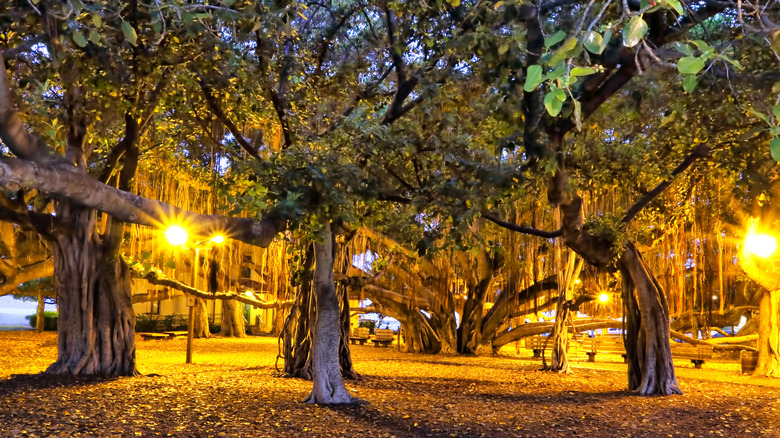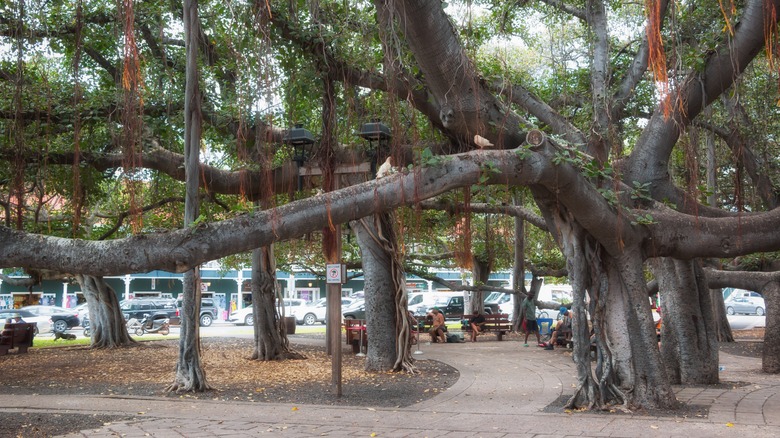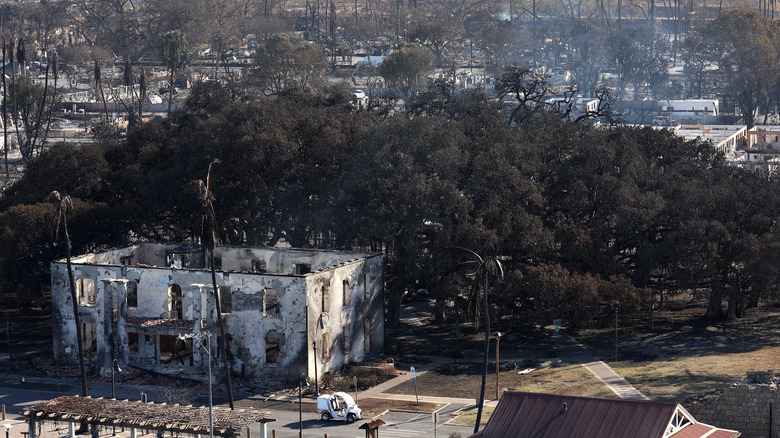How The Iconic Lahaina Banyan Got To Hawaii
The devastating 2023 wildfires on Maui threatened the life of a large banyan tree, a historic landmark that grew in the town of Lahaina for 150 years, The New York Times reports. The tree began its life in India and was brought to Hawaii in 1873 on the 50th anniversary of the first Protestant mission in the area. Since then, the tree has become a gathering place for Lahaina visitors and residents, growing over 60 feet tall. In total, the tree's multi-trunk footprint occupies almost an acre, while the tree's canopy alone shades about two-thirds of that space.
In its lifespan, the Lahaina Banyan has become a symbol of Hawaiian history post-Western colonization — beginning in the late 18th and early 19th centuries — as well as missionary work. When it arrived, Lahaina was the capital of the Kingdom of Hawaii, but about 25 years after it was planted, the island chain became a United States territory, and after that, a U.S. state. As it grew throughout that time, the tree and its surrounding park became a point of pride for Maui residents.
Referring to the giant tree, John Sandbach, who lives on Maui, said (via The Guardian), "There's just so much meaning attached to it and there's so many experiences that everyone has. It's in the heart of a historic town."
The heartbeat of Lahaina
Long before the Lahaina banyan was planted, the Hawaiian islands had a rich and varied history. The first known Westerner to set foot in Hawaii was Captain James Cook, who arrived in 1778. As was often the case with colonization, missionaries from all over the world followed shortly after Cook landed. Beginning in the 1820s, those Hawaiian missionaries were not just from Europe, but also from India, where Protestantism was introduced in 1683 by European missionaries.
Banyans are native to India, and in 1873, the Lahaina Banyan was presented to then Maui Sherriff William Owen Smith as a gift. When it was planted, it was only around 8 feet tall, and as it developed, it saw the whaling industry and finally tourism drive Lahaina's economy.Today, there are notable banyans elsewhere on the islands, but the Lahaina Banyan is likely the largest example not just in Hawaii, but anywhere else in the U.S.
For these reasons and more, in the more than a century since it was a sapling, the Lahaina Banyan has come to be called "the Heartbeat of Lahaina." In 2016, then-manager of the Lahaina Visitor's Center Amy Fuqua told the Associated Press, "It's kind of the center of town. Everyone knows where it's at. It has an important significance to the town and it feels good under there."
Lahaina threw the Banyan a birthday party
Another sign of just how important the Lahaina Banyan is to people who live in the area, only a few months before the catastrophic 2023 Maui wildfires sparked, Lahaina residents celebrated the Banyan tree with a birthday party and cake, The Maui News reported. Over the years, much of the caretaking work has been overseen by the Lahaina Restoration Foundation. To encourage the banyan's growth — characterized by complex root structures that meet the ground at several points as new trunks — Lahaina residents have reportedly hung water jars from potential new roots as they extend out into the air, weighing them down and encouraging new root systems to take shape.
Though badly burned in the 2023 blaze, early reports were mixed about whether the historic Lahaina Banyan would make it. In a web update, island officials said it was unclear how badly the roots were damaged — an indicator of whether or not the tree might heal. Meanwhile, University of Hawaii extension forester James B. Friday told The Times, "It certainly doesn't look like that tree is going to recover." But Lahaina Restoration Foundation executive director Theo Morrison added (via NYT), "Banyan trees are hard to kill." (The burned Lahaina Banyan can be seen above.)


